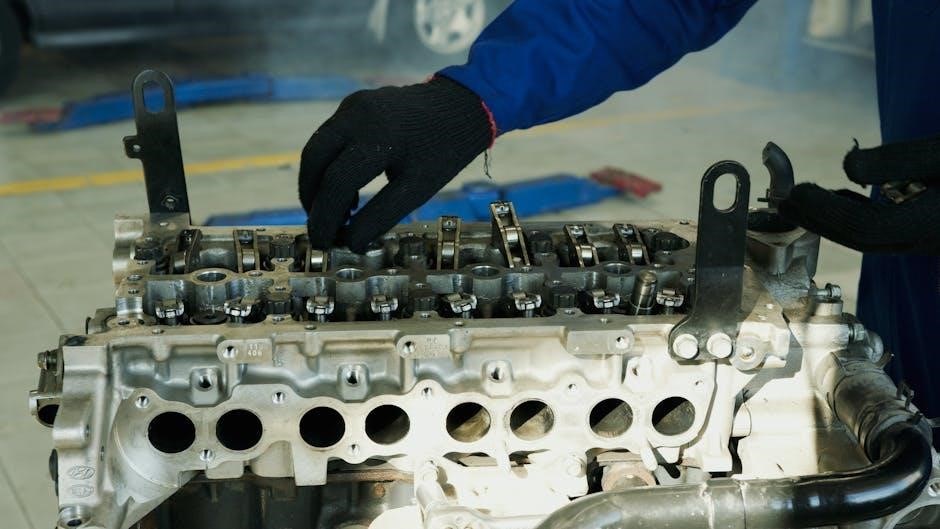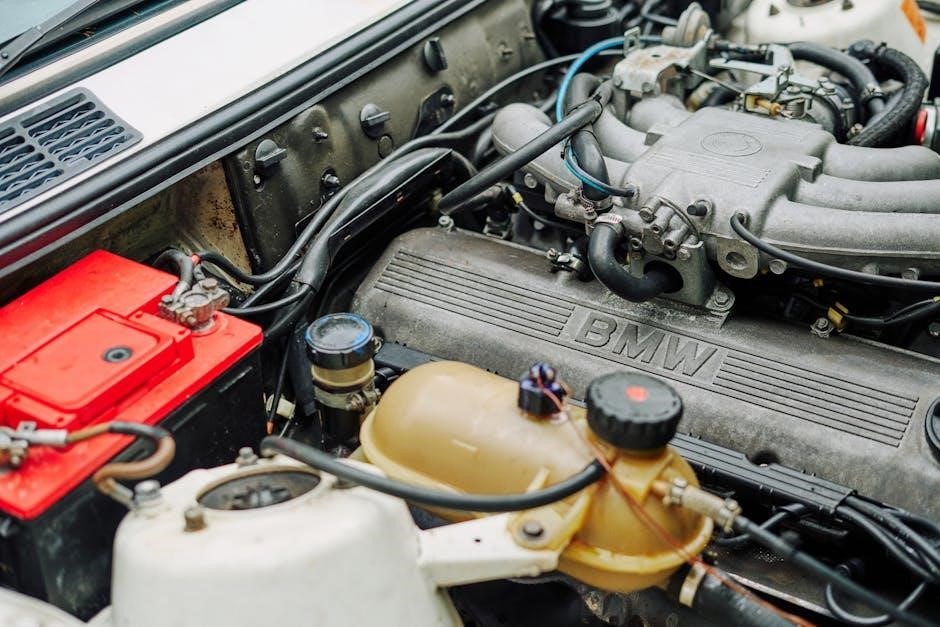
manual de motor detroit serie 60 12.7 litros
Welcome to the Detroit Series 60 12.7L engine manual, a comprehensive guide for understanding and managing this powerful engine. This manual provides essential insights into operation, maintenance, and troubleshooting to maximize performance and longevity. Designed for professionals and enthusiasts, it covers key aspects to ensure optimal functionality and compliance with standards.
1.1 Overview of the Detroit Series 60 Engine
The Detroit Series 60 12.7L engine is a legendary powertrain renowned for its durability, reliability, and exceptional performance in heavy-duty applications. Designed for trucks, industrial, and marine use, it delivers impressive horsepower and torque while maintaining fuel efficiency. Known for its robust design, the engine features a 12.7-liter displacement, six-cylinder configuration, and a range of horsepower options to suit various demands. Its advanced engineering includes a high-strength cylinder block, overhead camshaft, and a fuel system optimized for power and efficiency. Widely respected in the industry, the Series 60 engine has become a benchmark for heavy-duty applications, offering a balance of power, reliability, and long-term durability.
1.2 Importance of the Manual
This manual is an essential resource for anyone working with the Detroit Series 60 12.7L engine, providing critical information for optimal performance and longevity. It serves as a guide for understanding the engine’s capabilities, proper maintenance procedures, and troubleshooting techniques. By following the manual, users can ensure safe operation, prevent potential damage, and maintain compliance with emissions and safety standards. Whether for routine upkeep or complex repairs, this manual offers clear, detailed instructions to help users achieve peak performance and reliability. It is a vital tool for professionals, mechanics, and enthusiasts, ensuring the engine operates efficiently and effectively under all conditions.
1.3 Target Audience
This manual is specifically designed for professionals, mechanics, and enthusiasts working with the Detroit Series 60 12.7L engine. It caters to a wide range of users, including heavy-duty truck operators, fleet managers, and service technicians. Additionally, it serves as a valuable resource for engineering students and diesel engine specialists seeking in-depth knowledge. The manual’s content is tailored to assist those requiring detailed technical information for installation, maintenance, troubleshooting, and repair. Whether you’re a seasoned technician or a newcomer to diesel engine technology, this manual provides the necessary insights and guidance to ensure effective and efficient engine operation. Its comprehensive approach makes it an indispensable tool for anyone involved with this engine.

Engine Specifications
The Detroit Series 60 12.7L engine is a high-performance diesel powerplant, featuring a displacement of 12.7 liters and a 6-cylinder inline configuration. It delivers impressive horsepower and torque ratings, optimized for heavy-duty applications. The engine utilizes a state-of-the-art fuel injection system and incorporates advanced technologies for efficiency and reliability. With its robust design and adherence to strict emission standards, the Series 60 is a trusted choice for commercial vehicles and industrial machinery. This section provides a detailed overview of the engine’s key specifications, ensuring proper understanding and utilization of its capabilities.
2.1 Engine Overview
The Detroit Series 60 12.7L engine is a high-performance, heavy-duty diesel engine designed for maximum power and efficiency. Built with a robust 6-cylinder inline configuration, it is optimized for heavy-duty trucking, industrial, and marine applications. Known for its reliability and durability, the engine features advanced technologies such as electronic fuel injection and a precision-engineered combustion system. Its design emphasizes fuel efficiency, reduced emissions, and smooth operation under demanding conditions. The Series 60 is widely recognized for its versatility, making it a popular choice for various industries requiring consistent and powerful performance. This overview highlights the engine’s core design and operational capabilities, setting the foundation for detailed specifications in subsequent sections.
2.2 Displacement and Configuration
The Detroit Series 60 12.7L engine features a displacement of 12.7 liters, achieved through a 6-cylinder inline configuration. This design provides a balance of power and efficiency, with each cylinder contributing to the engine’s overall performance. The inline layout allows for a compact design, simplifying maintenance and enhancing reliability. The engine’s bore and stroke measurements are optimized to deliver maximum torque and horsepower while minimizing fuel consumption. The 6-cylinder configuration ensures smooth operation and reduced vibration compared to smaller engines. This combination of displacement and configuration makes the Series 60 ideal for heavy-duty applications, offering both power and efficiency in demanding environments. These specifications are fundamental to understanding the engine’s capabilities and operational characteristics.
2.3 Horsepower and Torque Ratings
The Detroit Series 60 12.7L engine delivers impressive horsepower and torque ratings, making it a reliable choice for heavy-duty applications. The engine is available in multiple power ratings, ranging from 350 to 500 horsepower, depending on the specific configuration and application. Torque ratings correspondingly range from 1,200 to 1,650 lb-ft, ensuring exceptional pulling power and performance under load. These ratings are optimized to provide a balance between power and fuel efficiency, catering to various operational demands. The engine’s horsepower and torque outputs are strategically designed to meet the needs of long-haul trucking, construction, and industrial machinery. These specifications ensure the Detroit Series 60 engine remains a cornerstone of heavy-duty powertrain solutions.
2.4 Fuel System Overview
The Detroit Series 60 12.7L engine features a high-pressure common rail fuel injection system designed for optimal performance and efficiency. The system incorporates advanced fuel injectors that deliver precise fuel quantities under high pressure, ensuring efficient combustion and reduced emissions. The engine is equipped with dual fuel pumps, including a lift pump for fuel supply and a high-pressure pump for injection. The fuel system also includes a fuel filter system with a water separator to maintain fuel purity and prevent contamination. This design ensures reliable operation in various conditions. The system is controlled by the Electronic Control Module (ECM), which monitors fuel flow and injection timing for maximum performance and fuel economy.
2.5 Cooling System Specifications
The Detroit Series 60 12.7L engine is equipped with a robust cooling system designed to maintain optimal operating temperatures. The system includes a high-capacity radiator with an aluminum core and a gear-driven water pump for efficient coolant circulation. The coolant mixture typically consists of a 50/50 blend of ethylene glycol and water, ensuring freeze and corrosion protection. The system also features a thermostat that regulates engine temperature by controlling coolant flow. The cooling fan is electric and equipped with a viscous clutch for improved efficiency. Proper maintenance, including regular coolant checks and hose inspections, is essential to prevent overheating and ensure reliable performance. Adhering to the recommended coolant specification is critical for longevity and efficiency.
2.6 Emission Standards Compliance
The Detroit Series 60 12.7L engine is designed to meet stringent emission standards, including EPA and Euro norms, ensuring reduced environmental impact. Equipped with advanced emission control technologies such as the DDEC (Detroit Diesel Electronic Control) system, cooled Exhaust Gas Recirculation (EGR), and Selective Catalytic Reduction (SCR) with Diesel Exhaust Fluid (DEF) injection, the engine minimizes emissions of nitrogen oxides (NOx) and particulate matter (PM). These systems work synergistically to maintain compliance while optimizing fuel efficiency and performance. Regular maintenance, such as filter replacements and software updates, is crucial to sustaining emissions compliance and ensuring the engine operates within regulatory requirements. Adherence to these standards contributes to a cleaner, more sustainable environment.

Design and Architecture
The Detroit Series 60 12.7L engine features a robust design with a high-strength cylinder block and crankshaft, ensuring durability and optimal weight distribution for heavy-duty applications.
3.1 Cylinder Block and Crankshaft
The Detroit Series 60 12.7L engine features a robust cylinder block designed for high strength and durability. The block is constructed from high-strength materials to withstand heavy-duty applications. The crankshaft is precision-engineered to ensure smooth operation and optimal power transmission. Its counterweights are carefully balanced to minimize vibrations and enhance engine stability. The cylinder block’s design incorporates advanced cooling channels for efficient heat management, while the crankshaft’s surface finish ensures minimal friction and maximum longevity; Together, these components form the backbone of the engine, providing the structural integrity and mechanical efficiency required for reliable performance in demanding environments.
3.2 Cylinder Head and Valvetrain
The Detroit Series 60 12.7L engine features a high-strength cylinder head designed to optimize performance and durability. Constructed from durable materials, the cylinder head incorporates advanced cooling passages to maintain optimal thermal balance. The design ensures efficient airflow and combustion chamber geometry for maximum fuel efficiency and power output.
The valvetrain components, including valves, springs, and retainers, are engineered for precise operation. The valves are made from high-temperature-resistant materials to withstand heavy-duty conditions. The valvetrain’s design minimizes wear and ensures consistent performance, while the valve guides and seats are precision-machined for smooth operation and longevity.
3.3 Fuel Injection System
The Detroit Series 60 12.7L engine features a high-pressure common rail fuel injection system, designed for precise fuel delivery and optimal combustion efficiency. This system utilizes electronically controlled fuel injectors to ensure accurate fuel atomization and injection timing, enhancing power output and reducing emissions. The fuel injectors are capable of multiple injection events per cycle, improving fuel efficiency and reducing noise.
The system is supported by advanced sensors and an Engine Control Module (ECM) that monitors engine conditions and adjusts fuel delivery accordingly. This ensures the engine operates efficiently across all load conditions, from idle to full power. The fuel injection system is critical for maintaining performance, fuel economy, and compliance with emissions standards. Proper maintenance and calibration are essential to preserve its functionality and reliability.
3.4 Turbocharger and Aftercooler

The Detroit Series 60 12.7L engine employs a high-efficiency turbocharger to boost performance by compressing intake air, enhancing power and torque. The turbocharger is designed with variable geometry technology, allowing optimal boost pressure across various engine speeds. An aftercooler is integrated to cool the compressed air before it enters the engine, increasing air density and improving combustion efficiency. This system significantly enhances horsepower, torque, and fuel efficiency while reducing emissions. The turbocharger and aftercooler work in harmony to ensure the engine operates efficiently under diverse load conditions, maintaining peak performance and adherence to emissions standards. Proper maintenance of these components is crucial for sustained reliability and optimal engine functionality.
3.5 Engine Control Module (ECM)
The Engine Control Module (ECM) is the central nervous system of the Detroit Series 60 12.7L engine, responsible for monitoring and controlling all critical engine functions. This sophisticated computer processes data from various sensors, including fuel injection timing, airflow, and temperature, to optimize performance, efficiency, and emissions. The ECM ensures precise fuel delivery, manages the turbocharger operation, and regulates exhaust gas recirculation for compliance with emissions standards. It also provides real-time diagnostics and stores fault codes for troubleshooting. Regular updates and calibrations are essential to maintain peak performance and adapt to operating conditions. Refer to the manual for ECM-specific troubleshooting and maintenance procedures to ensure optimal functionality and reliability.

Installation and Maintenance
This section provides detailed guidelines for installing and maintaining the Detroit Series 60 12.7L engine, ensuring proper function and longevity. It covers pre-installation checks, correct mounting, and essential maintenance routines to prevent issues and optimize performance. Adhering to these procedures guarantees reliability and compliance with safety standards.
4.1 Pre-Installation Checks
Before installing the Detroit Series 60 12.7L engine, perform a thorough inspection of all components. Check the engine block, cylinder head, and crankshaft for any signs of damage or wear. Ensure the cooling system is free from corrosion and blockages. Inspect the fuel system for leaks and confirm the correct fuel type is used. Verify all electrical connections are secure and undamaged. Lubrication systems must be checked for proper oil levels and filter condition. Ensure mounting surfaces are clean and aligned correctly to prevent vibration issues. Finally, review the installation manual to confirm all specifications and torque values are met before proceeding.
4.2 Installation Guidelines
Follow these steps for a successful Detroit Series 60 12.7L engine installation. Begin by aligning the engine with the chassis or equipment, ensuring proper mounting surface compatibility. Tighten engine mounts in a star pattern to avoid uneven stress. Connect the cooling system hoses securely, ensuring correct flow direction. Install the fuel lines, priming the system to avoid air pockets. Attach the electrical connectors to the ECM and sensors, verifying polarity. Connect the throttle and gear linkage, adjusting for smooth operation. Fill the cooling system with the recommended coolant mixture and top off the oil to the specified level. Finally, start the engine and check for leaks or unusual noises before full operation.
4.3 Routine Maintenance Schedule
Adhere to the following routine maintenance schedule to ensure optimal performance and longevity of the Detroit Series 60 12.7L engine. Daily, check oil and coolant levels, and inspect for leaks. Weekly, clean or replace the air filter and inspect serpentine belts for wear. Every 50 hours, change the oil and oil filters, and inspect the fuel filters. At 100 hours, replace the fuel filters and check the coolant condition. Every 200 hours, inspect and adjust the valve lash and clean the turbocharger. Annually or at 500 hours, flush and refill the cooling system and inspect all hoses. Regular maintenance prevents costly repairs and ensures reliable operation.
4.4 Oil and Filter Change Procedures
To perform an oil and filter change on the Detroit Series 60 12.7L engine, start by gathering the necessary materials, including the correct oil filter and oil type. Warm the engine to ensure the oil drains completely. Locate the oil drain plug, position a drain pan underneath, and remove the plug to allow the oil to flow out. Replace the plug securely once the oil stops dripping. Next, remove the old oil filter and install a new one, ensuring it is properly seated. Refill the engine with the recommended oil type and quantity as specified in the manufacturer’s guidelines. Dispose of the used oil and filter responsibly. Refer to the manufacturer’s specifications for exact details.
4.5 Cooling System Maintenance
Regular maintenance of the cooling system is critical to prevent overheating and ensure optimal engine performance. Start by checking the coolant level and ensuring it meets the recommended 50/50 mixture of antifreeze and distilled water. Inspect the hoses, belts, and connections for signs of wear, cracks, or leaks, and replace them if necessary. Clean the radiator fins gently to remove debris and ensure proper airflow. Check the fan clutch for proper operation and verify that the temperature sensor is functioning accurately. Drain and flush the coolant system every 2 years or as specified in the maintenance schedule. Use a high-quality coolant compatible with the Detroit Series 60 engine to maintain corrosion protection and heat transfer efficiency.

Troubleshooting and Repair
This section provides detailed procedures for identifying and resolving common issues in the Detroit Series 60 12.7L engine. Learn to diagnose symptoms, perform repairs, and ensure reliability.
5.1 Common Issues and Symptoms
The Detroit Series 60 12.7L engine may experience issues such as rough idling, stalling, or low power output. Symptoms like excessive smoke, unusual noises, or overheating can indicate underlying problems. Common causes include faulty fuel injectors, turbocharger failures, or clogged air filters. Additionally, issues with the ECM or sensor malfunctions can trigger warning lights or erratic performance. Regular monitoring of these symptoms and addressing them promptly is crucial to prevent further damage. Always refer to diagnostic tools and the ECM for accurate troubleshooting to ensure reliable engine operation and maintain peak performance.
5.2 Diagnostic Procedures
Diagnosing issues with the Detroit Series 60 12.7L engine begins with consulting the Engine Control Module (ECM) for fault codes. Use a compatible diagnostic tool to retrieve and interpret these codes. Perform a visual inspection of hoses, connections, and components for signs of damage or leaks. Check system pressures, such as fuel and coolant, to identify deviations from specifications. Test electrical circuits and sensors for proper function using a multimeter. Always refer to the troubleshooting charts in this manual to isolate the root cause of symptoms. If issues persist, consult an authorized service center for advanced assistance and repairs. Adhere to safety guidelines during diagnostics to avoid injury or further damage.
5.3 Repair and Replacement Guidelines
Repairs and replacements on the Detroit Series 60 12.7L engine must adhere to strict guidelines to ensure reliability and performance. Always use factory-approved tools and follow torque specifications to prevent damage. Consult exploded diagrams in this manual for accurate disassembly and reassembly procedures. Replace worn or damaged components with genuine parts to maintain OEM standards. After completing repairs, perform a series of tests, including leak checks and system functionality tests, to confirm proper operation. Dispose of hazardous materials, such as used oil and filters, in accordance with environmental regulations. Avoid improvising repairs, as this can lead to premature wear or engine failure. For complex issues, seek assistance from a certified technician.

Emissions and Environmental Considerations
This section outlines how the Detroit Series 60 12.7L engine meets emission standards, reducing environmental impact through advanced technologies and sustainable practices for eco-friendly performance.

6.1 Emission Control Technologies
The Detroit Series 60 12.7L engine incorporates advanced emission control technologies to minimize environmental impact. Key systems include the Exhaust Gas Recirculation (EGR) system, which reduces nitrogen oxide emissions by recirculating a portion of exhaust gases into the combustion chamber. Additionally, the engine features a Diesel Particulate Filter (DPF) to capture and reduce soot and particulate matter. The Selective Catalytic Reduction (SCR) system further enhances emission reduction by converting nitrogen oxides into harmless nitrogen and water using a catalyst and urea injection. These technologies work in harmony to ensure compliance with stringent EPA standards while maintaining engine performance and fuel efficiency, making the Detroit Series 60 a leader in environmentally responsible diesel engine design.
6.2 Environmental Impact and Regulations
The Detroit Series 60 12.7L engine is designed to meet strict environmental regulations, ensuring reduced emissions and minimized ecological footprint. Compliance with EPA standards is achieved through advanced emission control technologies. The engine’s efficient combustion process and aftertreatment systems significantly lower greenhouse gas emissions and particulate matter; Regular maintenance, as outlined in this manual, plays a crucial role in sustaining compliance and reducing environmental impact. Operators must adhere to local and federal regulations, including proper disposal of fluids and waste. By following the guidelines in this manual, users can contribute to sustainable practices while operating the Detroit Series 60 engine responsibly.

Appendices
The appendices provide additional resources, including a glossary of technical terms, tools required for maintenance, and reference materials for further study. These sections enhance understanding and practical application.
7.1 Glossary of Terms
This section defines key technical terms used throughout the manual, ensuring clarity for users. Terms like Aftercooler (cools compressed air) and Crankshaft (converts reciprocating motion to rotary) are explained. ECM refers to the Engine Control Module, which manages engine functions. Turbocharger boosts power by compressing air, while Injectors deliver fuel to cylinders. Understanding these terms aids in effective troubleshooting and maintenance. Additional definitions cover components like Cylinder Head and Valvetrain, critical for engine operation. This glossary serves as a quick reference, making complex terminology accessible for all users, from novices to experienced technicians, ensuring optimal engine performance and longevity.
7.2 Tools and Equipment Required
Proper tools and equipment are essential for efficient and safe servicing of the Detroit Series 60 12.7L engine. Common tools include wrenches, screwdrivers, pliers, and a multimeter for diagnostics. Specialized tools like a compression tester, oil drain pan, and jack stands are necessary for specific tasks. A hydraulic press may be required for bearing and seal replacements. Alignment tools ensure proper installation of components. Diagnostic software and a laptop are crucial for interfacing with the ECM. Safety equipment, such as safety glasses and gloves, is mandatory. Additionally, a well-organized workspace with access to air compressors and lifting equipment enhances efficiency. Always consult the workshop manual for specific tools needed for particular procedures to ensure accuracy and safety.
7.3 Reference Materials and Resources
This section provides a list of essential reference materials and resources for the Detroit Series 60 12.7L engine. Official Detroit Diesel service manuals and technical bulletins are primary sources for accurate information. Diagnostic guides, wiring diagrams, and parts catalogs are indispensable for repairs and maintenance. Manufacturer-approved websites and service bulletins offer updates and compliance information. Additional resources include training materials, troubleshooting guides, and emissions compliance documentation. These materials ensure technicians and operators have access to reliable data for optimal engine performance and adherence to regulations. Always refer to the latest editions of these resources for the most current and accurate information.

References
This manual references official Detroit Diesel documentation, industry standards, and technical specifications to ensure accuracy and compliance. Key sources include the Detroit Series 60 service manual, EPA emissions regulations, and SAE standards. Additional references are drawn from technical bulletins, manufacturer guidelines, and industry best practices. The information provided aligns with the latest updates from Detroit Diesel and regulatory bodies. For further details, consult the official Detroit Diesel website, technical service bulletins, and emissions compliance documents. This manual is not a substitute for the official factory service manual but serves as a supplementary guide based on available data and expert knowledge.

